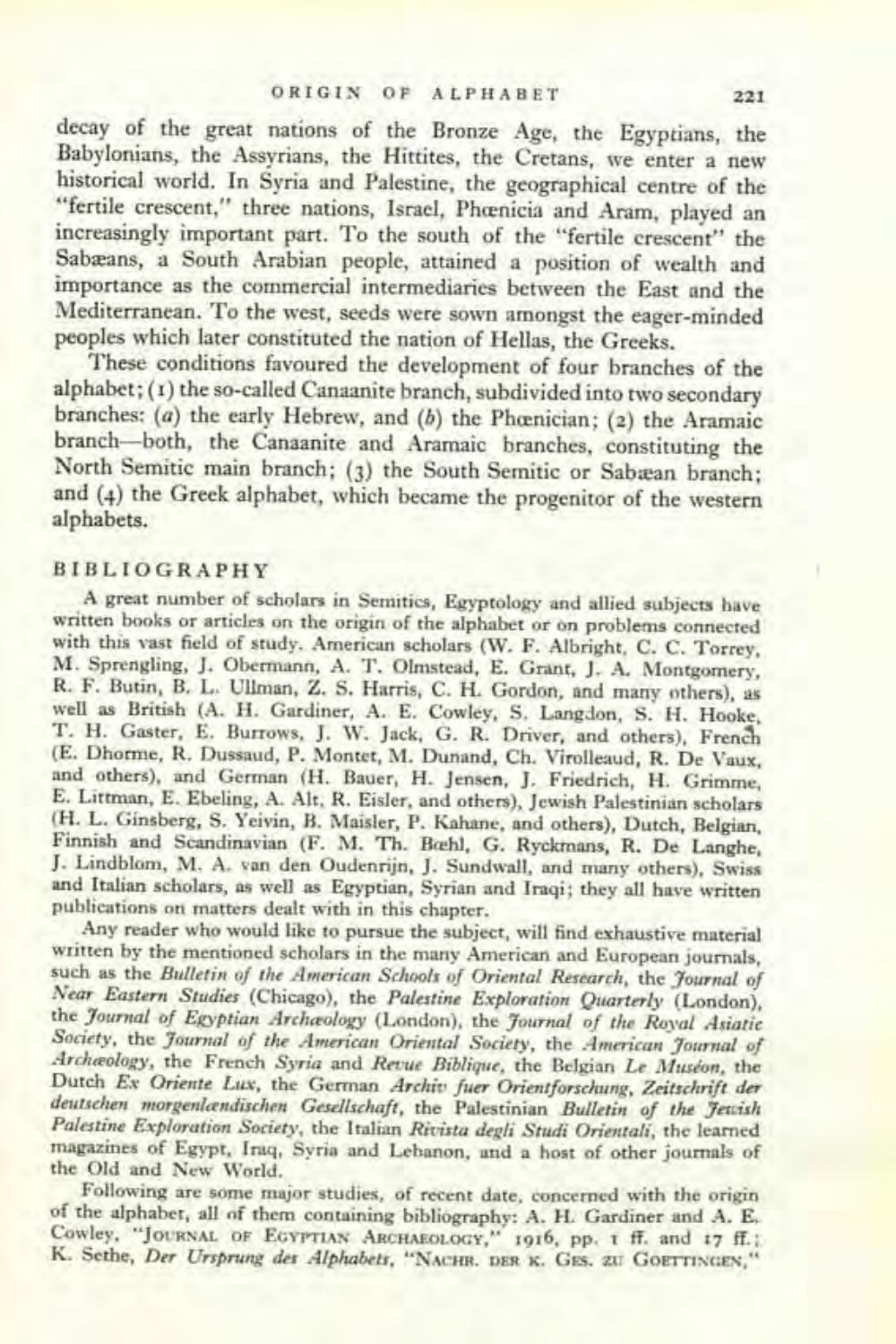________________
ORIGIN OF ALPHABET
221
decay of the great nations of the Bronze Age, the Egyptians, the Babylonians, the Assyrians, the Hittites, the Cretans, we enter a new historical world. In Syria and Palestine, the geographical centre of the "fertile crescent," three nations, Israel, Phoenicia and Aram, played an increasingly important part. To the south of the "fertile crescent" the Sabæans, a South Arabian people, attained a position of wealth and importance as the commercial intermediaries between the East and the Mediterranean. To the west, seeds were sown amongst the eager-minded peoples which later constituted the nation of Hellas, the Greeks.
These conditions favoured the development of four branches of the alphabet; (1) the so-called Canaanite branch, subdivided into two secondary branches: (a) the early Hebrew, and (b) the Phoenician; (2) the Aramaic branch-both, the Canaanite and Aramaic branches, constituting the North Semitic main branch; (3) the South Semitic or Sabæan branch; and (4) the Greek alphabet, which became the progenitor of the western alphabets.
BIBLIOGRAPHY
A great number of scholars in Semitics, Egyptology and allied subjects have written books or articles on the origin of the alphabet or on problems connected with this vast field of study. American scholars (W. F. Albright, C. C. Torrey, M. Sprengling, J. Obermann, A. T. Olmstead, E. Grant, J. A. Montgomery, R. F. Butin, B. L. Ullman, Z. S. Harris, C. H. Gordon, and many others), as well as British (A. H. Gardiner, A. E. Cowley, S. Langdon, S. H. Hooke, T. H. Gaster, E. Burrows, J. W. Jack, G. R. Driver, and others), French (E. Dhorme, R. Dussaud, P. Montet, M. Dunand, Ch. Virolleaud, R. De Vaux, and others), and German (H. Bauer, H. Jensen, J. Friedrich, H. Grimme, E. Littman, E. Ebeling, A. Alt, R. Eisler, and others), Jewish Palestinian scholars (H. L. Ginsberg, S. Yeivin, B. Maisler, P. Kahane, and others), Dutch, Belgian, Finnish and Scandinavian (F. M. Th. Bahl, G. Ryckmans, R. De Langhe, J. Lindblom, M. A. van den Oudenrijn, J. Sundwall, and many others), Swiss and Italian scholars, as well as Egyptian, Syrian and Iraqi; they all have written publications on matters dealt with in this chapter.
Any reader who would like to pursue the subject, will find exhaustive material written by the mentioned scholars in the many American and European journals, such as the Bulletin of the American Schools of Oriental Research, the Journal of Near Eastern Studies (Chicago), the Palestine Exploration Quarterly (London), the Journal of Egyptian Archaeology (London), the Journal of the Royal Asiatic Society, the Journal of the American Oriental Society, the American Journal of Archeology, the French Syria and Revue Biblique, the Belgian Le Muséon, the Dutch Ex Oriente Lux, the German Archiv fuer Orientforschung, Zeitschrift der deutschen morgenlændischen Gesellschaft, the Palestinian Bulletin of the Jewish Palestine Exploration Society, the Italian Rivista degli Studi Orientali, the learned magazines of Egypt, Iraq, Syria and Lebanon, and a host of other journals of the Old and New World.
Following are some major studies, of recent date, concerned with the origin of the alphabet, all of them containing bibliography: A. H. Gardiner and A. E. Cowley, "JOURNAL OF EGYPTIAN ARCHAEOLOGY," 1916, pp. 1 ff. and 17 ff.: K. Sethe, Der Ursprung des Alphabets, "NACHR. DER K. GES. ZU GOETTINGEN,"




